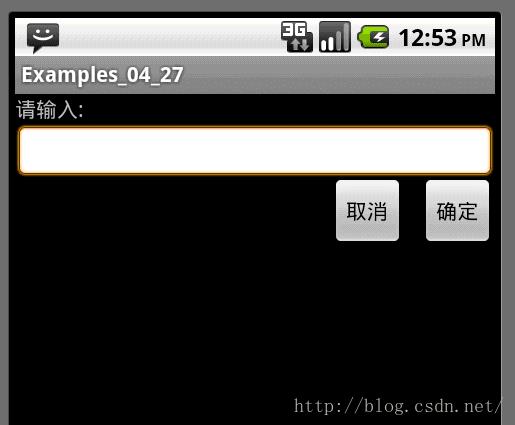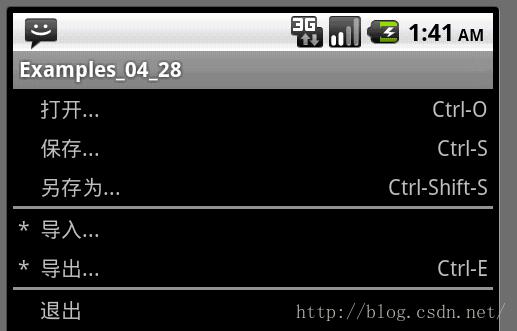Android进阶(二十七)Android原生扰人烦的布局
Posted No Silver Bullet
tags:
篇首语:本文由小常识网(cha138.com)小编为大家整理,主要介绍了Android进阶(二十七)Android原生扰人烦的布局相关的知识,希望对你有一定的参考价值。
Android原生扰人烦的布局
在开发android应用时,UI布局是一件令人烦恼的事情。下面主要讲解一下Android中的界面布局。
一、线性布局(LinearLayout)
线性布局分为:
(1)垂直线性布局;
(2)水平线性布局;
针对这两种区别,只是一个属性的区别
<LinearLayout xmlns:android="http://schemas.android.com/apk/res/android"
android:orientation="vertical"
android:layout_width="fill_parent"
android:layout_height="fill_parent">
</LinearLayout>
水平线性布局的话,android:orientation="horizontal" 即可。
二、 相对布局(RelativeLayout)
一般线性布局满足不了们实际项目中的需要,就是一般做Web界面的UI设计一样,也是存在相对元素的一些CSS样式的布局。RelativeLayout参数有:Width,Height,Below,AlignTop,ToLeft,Padding,和MerginLeft。
关键源码:
<RelativeLayout xmlns:android="http://schemas.android.com/apk/res/android"
android:layout_width="fill_parent"
android:layout_height="fill_parent">
<TextView
android:id="@+id/label"
android:layout_width="fill_parent"
android:layout_height="wrap_content"
android:text="请输入:"/>
<EditText
android:id="@+id/entry"
android:layout_width="fill_parent"
android:layout_height="wrap_content"
android:background="@android:drawable/editbox_background"
android:layout_below="@id/label"/>
<Button
android:id="@+id/ok"
android:layout_width="wrap_content"
android:layout_height="wrap_content"
android:layout_below="@id/entry"
android:layout_alignParentRight="true"
android:layout_marginLeft="10dip"
android:text="确定" />
<Button
android:layout_width="wrap_content"
android:layout_height="wrap_content"
android:layout_toLeftOf="@id/ok"
android:layout_alignTop="@id/ok"
android:text="取消" />
</RelativeLayout>
其中,android:layout_below=”@id/label”设置了EditText处于TextView下方;在Button中android:layout_below=”@id/entry”设置该Button位于EditText下。
实例效果:

三、表单布局(TableLayout)
TableLayout由许多TableRow组成,每个TableRow都会定义一个Row。TableLayout容器不会显示Row,Column或Cell的边框线,每个Row拥有0个或多个Cell,每个Cell拥有一个View对象。表格由行和列组成许多单元个,允许单元格为空。但是单元格不能跨列,这与html不同。
<View
android:layout_height="2dip"
android:background="#FF909090" />
<TableRow>
<TextView
android:text="*"
android:padding="3dip" />
<TextView
android:text="导入..."
android:padding="3dip" />
</TableRow>
<TableRow>
<TextView
android:text="*"
android:padding="3dip" />
<TextView
android:text="导出..."
android:padding="3dip" />
<TextView
android:text="Ctrl-E"
android:gravity="right"
android:padding="3dip" />
</TableRow>
实例效果:

android:gravity="center" 书面解释是权重比。其时就是让它居中显示。
android:stretchColumns="1,2,3,4" 它的意思就是自动拉伸1,2,3,4列。
注
若需实现组件居中显示,布局应如下:
android:layout_width="wrap_content"
android:layout_height="wrap_content"
android:layout_gravity="center_vertical|center_horizontal"
TableRow平分列
每一列的宽度设置为android:layout_width="0.0dip",在设置每一列的android:layout_weight=“1”
因为ayout_weight是将剩余空间按权重分配,而不是将全部空间按权重分配。
代码如下:
<TableRow
android:paddingTop="15px">
<Button
android:id="@+id/Register"
android:text="@string/register"
android:layout_width="0.0dip"
android:layout_weight="1"
android:onClick="register"/>
<Button
android:id="@+id/cancel"
android:layout_width="0.0dip"
android:layout_weight="1"
android:text="@string/button_cancel" />
</TableRow>
视图如下:

四、切换卡(TabWidget)
切换卡经常用在一下选项上,类似于电话簿界面,通过多个标签切换显示不同内容。而其中,TabHost是一个用来存放Tab标签的容器,通过getTabHost方法来获取TabHost的对象,通过addTab方法向容器里添加Tab。Tab在切换时都会产生一个事件,可以通过TabActivity的事件监听setOnTabChangedListener.
【扩展点】TabHost
类概述
提供选项卡(Tab页)的窗口视图容器。此对象包含两个子对象:一组是用户可以选择指定Tab页的标签;另一组是FrameLayout用来显示该Tab页的内容。个别元素通常控制使用这个容器对象,而不是设置在子元素本身的值。
(译者madgoat注:即使使用的是单个元素,也最好把它放到容器对象ViewGroup里)
内部类
interface TabHost.OnTabChangeListener
接口定义了当选项卡更改时被调用的回调函数
interface TabHost.TabContentFactory
当某一选项卡被选中时生成选项卡的内容
class TabHost.TabSpec
单独的选项卡,每个选项卡都有一个选项卡指示符,内容和tag标签,以便于记录.。
关键源码
<TabHost xmlns:android="http://schemas.android.com/apk/res/android"
android:id="@android:id/tabhost"
android:layout_width="fill_parent"
android:layout_height="fill_parent">
<LinearLayout
android:orientation="vertical"
android:layout_width="fill_parent"
android:layout_height="fill_parent">
<TabWidget
android:id="@android:id/tabs"
android:layout_width="fill_parent"
android:layout_height="wrap_content" />
<FrameLayout
android:id="@android:id/tabcontent"
android:layout_width="fill_parent"
android:layout_height="fill_parent">
<TextView
android:id="@+id/textview1"
android:layout_width="fill_parent"
android:layout_height="fill_parent"
android:text="this is a tab" />
<TextView
android:id="@+id/textview2"
android:layout_width="fill_parent"
android:layout_height="fill_parent"
android:text="this is another tab" />
<TextView
android:id="@+id/textview3"
android:layout_width="fill_parent"
android:layout_height="fill_parent"
android:text="this is a third tab" />
</FrameLayout>
</LinearLayout>
</TabHost>
处理类
//声明TabHost对象
TabHost mTabHost;
public void onCreate(Bundle savedInstanceState)
{
super.onCreate(savedInstanceState);
setContentView(R.layout.main);
//取得TabHost对象
mTabHost = getTabHost();
/* 为TabHost添加标签 */
//新建一个newTabSpec(newTabSpec)
//设置其标签和图标(setIndicator)
//设置内容(setContent)
mTabHost.addTab(mTabHost.newTabSpec("tab_test1")
.setIndicator("TAB 1",getResources().getDrawable(R.drawable.img1))
.setContent(R.id.textview1));
mTabHost.addTab(mTabHost.newTabSpec("tab_test2")
.setIndicator("TAB 2",getResources().getDrawable(R.drawable.img2))
.setContent(R.id.textview2));
mTabHost.addTab(mTabHost.newTabSpec("tab_test3")
.setIndicator("TAB 3",getResources().getDrawable(R.drawable.img3))
.setContent(R.id.textview3));
//设置TabHost的背景颜色
mTabHost.setBackgroundColor(Color.argb(150, 22, 70, 150));
//设置TabHost的背景图片资源
//mTabHost.setBackgroundResource(R.drawable.bg0);
//设置当前显示哪一个标签,默认下标从0开始
mTabHost.setCurrentTab(0);
//标签切换事件处理,setOnTabChangedListener
mTabHost.setOnTabChangedListener(new OnTabChangeListener(){
public void onTabChanged(String tabId) {
Dialog dialog = new AlertDialog.Builder(Examples_04_29Activity.this)
.setTitle("提示")
.setMessage("当前选中:"+tabId+"标签")
.setPositiveButton("确定",
new DialogInterface.OnClickListener() {
public void onClick(DialogInterface dialog, int whichButton){
dialog.cancel();
}
}).create();//创建按钮
dialog.show();
}
});
}
实例效果:

参考文献
1.http://blog.csdn.net/fancylovejava/article/details/45787729/
美文美图


以上是关于Android进阶(二十七)Android原生扰人烦的布局的主要内容,如果未能解决你的问题,请参考以下文章